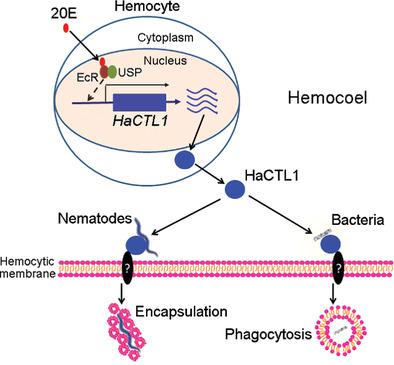当前位置:
X-MOL 学术
›
Insect Sci.
›
论文详情
Our official English website, www.x-mol.net, welcomes your
feedback! (Note: you will need to create a separate account there.)
Steroid hormone 20-hydroxyecdysone promotes CTL1-mediated cellular immunity in Helicoverpa armigera
Insect Science ( IF 2.9 ) Pub Date : 2020-07-16 , DOI: 10.1111/1744-7917.12851 Gui-Jie Wang 1 , Wen-Wen Wang 1 , Yu Liu 1 , Lian-Qin Chai 2 , Guo-Xiu Wang 1 , Xu-Sheng Liu 1 , Yu-Feng Wang 1 , Jia-Lin Wang 1
Insect Science ( IF 2.9 ) Pub Date : 2020-07-16 , DOI: 10.1111/1744-7917.12851 Gui-Jie Wang 1 , Wen-Wen Wang 1 , Yu Liu 1 , Lian-Qin Chai 2 , Guo-Xiu Wang 1 , Xu-Sheng Liu 1 , Yu-Feng Wang 1 , Jia-Lin Wang 1
Affiliation

|
Mermithid nematodes, such as Ovomermis sinensis, are used as biological control agents against many insect pests, including cotton bollworm (Helicoverpa armigera). However, given the host's robust immune system, the infection rate of O. sinensis is low, thus restricting its widespread use. To understand the host defense mechanisms against mermithid nematodes, we identified and characterized a protein involved in the recognition of O. sinensis, the potential O. sinensis-binding protein C-type lectin 1 (HaCTL1a and/or HaCTL1b), which was eluted from the surface of O. sinensis after incubation with H. armigera plasma. HaCTL1b is homologous to the previously reported HaCTL1a protein. HaCTL1 was predominantly expressed in hemocytes and was induced by the steroid hormone 20-hydroxyecdysone through ecdysone receptor (HaEcR) or ultraspiracle (HaUSP), or both. Binding assays confirmed the interactions of the HaCTL1 proteins with O. sinensis but not with Romanomermis wuchangensis, a parasitic nematode of mosquito. Moreover, the HaCTL1 proteins were secreted into the hemocoel and promoted hemocyte-mediated encapsulation and phagocytosis. A knockdown of HaEcR and/or HaUSP resulted in compromised encapsulation and phagocytosis. Thus, HaCTL1 appears to modulate cellular immunity in the defense against parasitic nematodes, and the 20-hydroxyecdysone–HaEcR–HaUSP complex is involved in regulating the process.
中文翻译:

类固醇激素 20-羟基蜕皮激素促进棉铃虫 CTL1 介导的细胞免疫
Mermithid 线虫,例如Ovomermis sinensis,被用作对抗许多害虫的生物防治剂,包括棉铃虫 ( Helicoverpa armigera )。然而,鉴于宿主强大的免疫系统,O的感染率。sinensis含量低,从而限制了其广泛使用。为了了解宿主针对线虫的防御机制,我们鉴定并表征了一种参与O识别的蛋白质。冬虫夏草,潜在Ò。吸虫结合蛋白C型凝集素1(HaCTL1a和/或HaCTL1b),将其从表面洗脱O.吸虫与温育后H . 棉铃虫血浆。HaCTL1b 与之前报道的 HaCTL1a 蛋白同源。HaCTL1 主要在血细胞中表达,并由类固醇激素 20-羟基蜕皮激素通过蜕皮激素受体 (HaEcR) 或超气门 (HaUSP) 或两者诱导。结合测定证实了 HaCTL1 蛋白与O的相互作用。sinensis,但不与Romanomermis wuchangensis,一种蚊子的寄生线虫。此外,HaCTL1 蛋白被分泌到血腔中并促进血细胞介导的包裹和吞噬作用。HaEcR 和/或 HaUSP 的组合式导致封装和吞噬作用受损。因此,HaCTL1 似乎在防御寄生线虫时调节细胞免疫,而 20-羟基蜕皮激素-HaEcR-HaUSP 复合物参与调节该过程。
更新日期:2020-07-16
中文翻译:

类固醇激素 20-羟基蜕皮激素促进棉铃虫 CTL1 介导的细胞免疫
Mermithid 线虫,例如Ovomermis sinensis,被用作对抗许多害虫的生物防治剂,包括棉铃虫 ( Helicoverpa armigera )。然而,鉴于宿主强大的免疫系统,O的感染率。sinensis含量低,从而限制了其广泛使用。为了了解宿主针对线虫的防御机制,我们鉴定并表征了一种参与O识别的蛋白质。冬虫夏草,潜在Ò。吸虫结合蛋白C型凝集素1(HaCTL1a和/或HaCTL1b),将其从表面洗脱O.吸虫与温育后H . 棉铃虫血浆。HaCTL1b 与之前报道的 HaCTL1a 蛋白同源。HaCTL1 主要在血细胞中表达,并由类固醇激素 20-羟基蜕皮激素通过蜕皮激素受体 (HaEcR) 或超气门 (HaUSP) 或两者诱导。结合测定证实了 HaCTL1 蛋白与O的相互作用。sinensis,但不与Romanomermis wuchangensis,一种蚊子的寄生线虫。此外,HaCTL1 蛋白被分泌到血腔中并促进血细胞介导的包裹和吞噬作用。HaEcR 和/或 HaUSP 的组合式导致封装和吞噬作用受损。因此,HaCTL1 似乎在防御寄生线虫时调节细胞免疫,而 20-羟基蜕皮激素-HaEcR-HaUSP 复合物参与调节该过程。











































 京公网安备 11010802027423号
京公网安备 11010802027423号